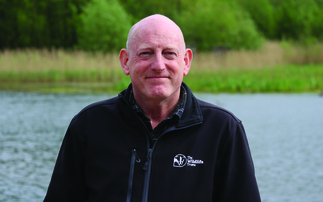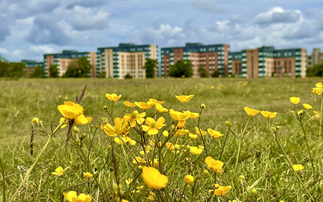Atkins' associate director and technical authority for biodiversity and natural capital Claire Wansbury highlights the many benefits of targeting environmental net gain
As part of the Festival of Nature, Atkins celebrates with an article series that highlights and reflects on our contribution towards a sustainable society, and how this is embedded in every project we undertake. It's not a part of what we do - it's who we are.
The first topic in the series is Environmental Net Gain, and we bring you insight and expertise from Claire Wansbury, Atkins' associate director and technical authority for biodiversity and natural capital across UK and Europe. She provides first-hand knowledge on environmental net gain and how this has been successfully delivered across the sector.
The importance of net gain
Developers across all sectors in the UK are being asked to provide 'biodiversity net gain' at an increasing pace, including us here at Atkins. Biodiversity is the variety of life on earth, including ecosystems, habitats and species; it's a key part of our natural capital, underpinning most ecosystem services.
For context - biodiversity net gain occurs when development leaves biodiversity in a better state than before. This means a project would result in an overall increase in biodiversity following a new development, measurable using a habitat-based metric as a proxy representing biodiversity value. This is Atkins' aspiration in all of our projects.
Atkins are at the forefront of the biodiversity net gain approach, contributing to best-practice guidance and then testing new methods and metrics on our clients' projects to help create what are now becoming national standards.
In this article I have combined our work on biodiversity net gain with over a decade's experience in Natural Capital valuation to reflect on what wider environmental net gain could, and indeed should, look like.
As well as becoming a legal necessity as a result of the Environment Bill, biodiversity net gain can also be a key part of the action needed to combat climate and biodiversity emergencies - again, something of huge importance to our company and one we want to ensure happens as widely as possible.
Adding value, to go the extra mile
Biodiversity net gain must deliver genuine improvements for nature. However, it can also bring enhanced natural capital value, creating direct benefits in other ways. This is environmental net gain.
As Defra explains: 'Achieving environmental net gain means achieving biodiversity net gain first, and going further to achieve net increases in the capacity of affected natural capital to deliver ecosystem services.'
It can be daunting to know where to start with what added value can be provided through biodiversity net gain interventions. Developers, ecologists and designers need to collaborate to deliver genuine environmental net gain.
By applying this attitude to projects, Atkins colleagues and I have increasingly realised that good design can deliver for nature and for people, creating this environmental net gain, which itself then provides a wealth of social value.
In order to help designers consider these opportunities, Atkins identified three key types of potential added value, which can be seen in the below text and diagram:
Carbon capture - habitat creation and restoration can make an important contribution to mitigating climate change. Examples include tree planting (with the right trees in the right places) and wetland creation.
Climate change adaptation and resilience - helping protect infrastructure and homes, for example, from increased flood risk caused by climate change and other factors such as urbanisation.
Health and wellbeing - benefitting physical and mental health through improved access to, and engagement with nature, and air quality improvement.
Each biodiversity net gain intervention won't always deliver on all three types of added value. Opportunities and priorities must be identified based on individual circumstances; this will inform the options available, and which should be selected to ensure the right intervention and deliver the best value for money. The ultimate result is optimum benefits for biodiversity, with added social value.
Let's get specific - Atkins examples
There are various tools and metrics to help inform decision making for net gain, with two main types at the forefront.
1. Defra and Natural England's 'Biodiversity Metric for Biodiversity Net Gain'. An example of Atkins' work in this area is with Redrow homes.
Even ahead of the government announcing plans to mandate biodiversity net gain for all new developments within England, Redrow Homes had already planned how they could implement this approach across their development sites. The ultimate aim: for net gain to become an integral part of the national biodiversity strategy, as well as the wider aspirational vision.
A pilot study was undertaken on three existing Redrow development sites using the Defra biodiversity metric. After a thorough assessment, Redrow were given an in-depth insight into how biodiversity net gain could be achieved in future developments.
As a result, Redrow have progressed their biodiversity strategy and have created measurable targets to enhance biodiversity within all of their sites.
2. The second type of tools to inform decision making for net gain are natural capital assessment tools, such as Atkins' natural capital studio. A study Atkins undertook for Spains Hall Estate demonstrated this aspect.
Land management changes including agroforestry, natural flood management and beaver release were being considered at the Spains Hall Estate. The aim was to enhance ecosystem service delivery across the landholding of this large estate. Atkins created a natural capital account of the current assets, along with an assessment of the predicted ecosystem value following these changes.
The potential changes in fifteen ecosystems were assessed to understand the financial value. The result was the potential benefits of nature-based solutions, including biodiversity, air quality and carbon capture, with significant additional social benefits. The increase in biodiversity benefits were a key part of the evidence basis for the Estate's successful application for Natural England's biodiversity net gain credit pilot.
As developers increasingly need to provide biodiversity net gain, this should provide wider benefits to the natural world and local communities.
This is an opportunity to unlock value that we cannot afford to miss. Good planning and design can allow habitat creation and enhancement that is undertaken with a primary driver of providing biodiversity net gain to deliver even wider environmental benefits - true environmental net gain.
Claire Wansbury is Atkins' associate director and technical authority for biodiversity and natural capital across UK and Europe.
This article is sponsored by Atkins.







